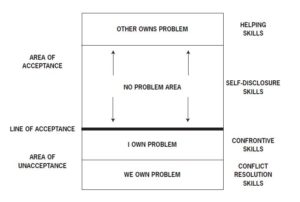by Steve Emmons
International Master Trainer, Gordon Training International
All of us who are parents want the best for our kids. We don’t like to see them in pain, upset, sad or frustrated about something. It’s almost a natural instinct to want to jump in and protect them from whatever problem or conflict they are experiencing. We do it without even thinking.
We know what it’s like to be treated unfairly, to be picked on or to go through a breakup. We’ve all been there; after all, we were kids once too, so we have a lot of experience dealing with problems and conflicts and we have a lot of great solutions that have worked for us in the past (and also a lot of learning from those that didn’t work so well).
And there lies part of the problem; we have solutions that have worked for us. It doesn’t mean that they are the best or even the right solutions for our child or teen. They are  different people with different personalities and needs in situations that are not exactly the same as ours were at their age. Times have changed.
different people with different personalities and needs in situations that are not exactly the same as ours were at their age. Times have changed.
In fact, while our actions to help and to solve our children’s problems are well intentioned, they may do just the opposite. We may not be so helpful after all; sometimes our solutions to their problems may even make their problem worse or may not even address the real underlying issue. Or, our solutions may work very well, and in the long run our children may become dependent on us to solve their problems and make their decisions for them.
On the other hand, there are clearly times when we have a problem with our child’s behavior. They are not doing their chores, they are leaving their toys all over the house, they resist eating their vegetables or going to bed on time. Then there are all the other points of conflict; homework, TV, staying out late, time spent texting, talking or tweeting. The list goes on.
All of this brings up a number of questions; “Just whose problem is it anyway!?” “Is it my child’s problem?” “Is it my problem?” As we say in Parent Effectiveness Training, it’s essential to decide who “Owns” the problem first because that will determine what actions I need to take in order to resolve the conflict or solve the problem.
Because of our initial instinct to protect and help, it is very common for us as parents to take on and “own” our children’s problems. On the other hand, when they are behaving in ways that we find unacceptable, the reaction can be: “My child sure has a problem! He is not doing his chores!” or “My teen has a real problem: she’s two hours late getting home from her date!”
Is it your child who is really upset that he hasn’t done his chores? Just ask my granddaughters when they haven’t unloaded the dishwasher! They don’t usually think that they have any problem! The problem for them, as they see it sometimes, is having to unload the dishwasher in the first place; not the opposite. Does your teenage daughter really think she has a problem because she had extra time with her handsome boyfriend? I don’t think so…but she might start to worry about the wrath she’ll face from Dad about being late.
When the chores don’t get done, we have to do them or we have to spend the time and energy confronting our child about it. When our daughter comes home late, who is the one that’s been worried and can’t sleep? Me, the parent. In those situations, I’m the one that’s upset, frustrated and worried, and I am the one who is directly affected by the behavior of my child or teen.
So in those situations, while my first reaction might be; “My child has a problem!” In fact, since I’m the one who is bothered or whose needs aren’t getting met, it’s really my problem, I “Own” it.
Why is so important to get it right and decide who owns the problem before we take action? Think about your doctor, dentist or even your auto mechanic. Would your doctor write you a prescription or schedule an operation without an examination? Would your dentist start to drill your teeth or your mechanic start removing your head gasket before finding out what the problem was? I hope not. If they did, it might be time to talk to your lawyer! Taking action before knowing what the problem is can at best confuse the issue and at worst, put you in danger of using the wrong approach and causing an even greater problem.
In one of my workshops I had a dad who was an army officer. He expressed it very well in a military context; “Before we take an action or make a decision about what equipment we might need, we have to have a strategy. We need to understand what the problem is in order to decide on what tactics to use.”
Parents use the same method when it comes to problems and conflicts with their children. The tendency for many parents is to jump in and say or do something before really determining what the problem is, before deciding who “Owns” it.
So, exactly how do we determine who owns the problem? As we have seen, if we rely on our first instinct or initial feelings, we may assign the problem to the wrong person and jump in and say or do the wrong thing. What’s helpful here is to think in terms of behaviors instead of making snap judgments or using labels.
It’s human nature to make judgments and label people. For example: my child is inconsiderate, she is lazy, he is irresponsible, my daughter is rude. As we know from personal experience, when we use labels like these with our children they will almost always respond defensively. Instead, it’s important to focus on exactly what your child is or isn’t doing or what he or she is saying and then identify who is directly affected by that behavior. An easy way to identify a behavior is to ask yourself this question: “Can I take a picture of what my child is doing with a camera or can I record what she is saying?” If you can then it’s a behavior. You can’t take a picture of rude, messy, resentful or lazy, those are labels. You can’t make an auditory recording of rebellious. Take out your smart phone or tablet the next time you find yourself labeling your child and see what it is you can actually capture in pictures or words.
When you are dealing with a problem involving your child – or for that matter – your partner, friend, boss or coworker and determine if what they are doing or saying has a direct, “concrete”, negative effect on you and your ability to function, or if it blocks one or more of your needs. If so, then it belongs in the “I Own” the Problem category.
If it is your problem, then it calls for a message from you to them about what their behavior is, how it tangibly effects you and how you feel about it. This I-Message is a clear, non-blameful way to talk to your child and greatly reduces potential resistance. Your child is much more likely to listen to you, take responsibility for their behavior and be willing to change because you are not blaming, labeling or attacking them. You are simply describing the situation, expressing your feelings and asking for their help in resolving the problem.
On the other hand, when you determine that your son is the one who is directly affected, that he is the one who received the bad grade at school or your daughter is the one who is heartbroken because she broke up with her boyfriend, then it belongs in the “Child Owns” the problem area.
Knowing that it is your child’s problem lets you choose the right tools; you can use your Active Listening and helping skills to assist them in taking responsibility and solving their own problems instead of teaching them to becoming dependent on you to solve everything for them.
Determining Who Owns the Problem greatly reduces parental stress. Knowing that not all problems are your problems, that many really belong to your child, partner or others, can take the pressure off of you to feel like you have to solve everything. If a problem belongs to someone else you have two choices; you can choose to leave it to them to deal with which takes it off your plate of pressures, or, when it’s someone you care about and are genuinely concerned, you can be the most helpful by choosing to listen and provide assistance but you don’t have to be the one to solve it.
Two questions you may be left with are; exactly how do I “Active Listen“ and how do I formulate and send “I-Messages“? These are the essential, hands on skills that we teach in P.E.T.

